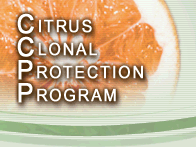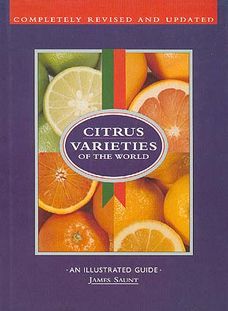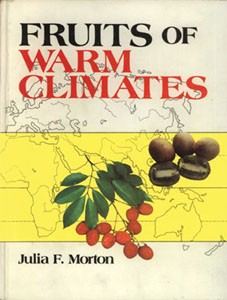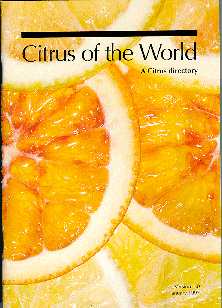|
||||||||||
|
|
 |
|||||||||
| Photo credits and citrus links |
|
Citrus Pages photo copyright
|
||||||||||||||||||||||||||||||||||||||||||||||||||||||||||||||||||||||||||||||||||||||||||||||||||||||
|
The first three organisations, two in California and one in France, made it originally possible to create Citrus Pages with their generous support and apparently inexhaustible supply of high quality citrus photographs.  
The Citrus Variety Collection of the University of California has given Citrus Pages permission to use their photographs. The Citrus Experiment Station and its Citrus Variety Collection were established in Riverside in the early 1900s to support the needs of the developing citrus industry in Southern California. Today UCR has expertise in many disciplines, yet the Citrus Variety Collection, consisting of two trees each of more than 1000 different citrus types, remains one of the premier citrus germplasm collections in the world and a valuable university resource. The university retains the copyright of their pictures, which are marked © UCR Citrus Variety Collection  The California Citrus Clonal Protection Program (CCPP) is part of the Department of Plant Pathology at the University of California at Riverside and is a cooperative program with the citrus growers of California, represented by the Citrus Research Board, the California Department of Food and Agriculture and the United States Department of Agriculture. This program serves both researchers and growers by providing a safe mechanism for the introduction of citrus varieties from around the world and then maintains these varieties in a protected, disease tested collection of important fruit and rootstock varieties that serve as as a primary source of propagating materials for California. Their pictures are marked: © CCPP |
||||||||||||||||||||||||||||||||||||||||||||||||||||||||||||||||||||||||||||||||||||||||||||||||||||||
|
The French National Institute for Agricultural Research has given Citrus Pages permission to use the photographs of the citrus collection in their agricultural research centre in San Giuliano on the island of Corsica in the Mediterranean. The centre was established in 1958 and has a collection of more than 1000 citrus types, four trees of each type, including over 240 types of mandarin. FNIAR retains the copyright of the pictures which are marked: © photographer / INRA, for example: © C. Jacquemond / INRA |
||||||||||||||||||||||||||||||||||||||||||||||||||||||||||||||||||||||||||||||||||||||||||||||||||||||
|
||||||||||||||||||||||||||||||||||||||||||||||||||||||||||||||||||||||||||||||||||||||||||||||||||||||
|
Grow your own citrus: |
||||||||||||||||||||||||||||||||||||||||||||||||||||||||||||||||||||||||||||||||||||||||||||||||||||||
This web-site provides
information and advice for non-commercial citrus growers
using the UK plants of Mike Saalfeld as examples. It describes notable citrus specimens and collections from around the world, taking special interest in the native Australian citrus species. Their pictures are marked: © Home Citrus Growers  Citrus Varieties of the World, Second completely revised and updated edition, by James Saunt is currently the best source of information on 235 most commonly grown citrus varieties. Mike Saalfeld has a few copies of this excellent, well-illustrated, hard-to-find book. Highly recommended. |
||||||||||||||||||||||||||||||||||||||||||||||||||||||||||||||||||||||||||||||||||||||||||||||||||||||
The citrus collection of Petr Broža in the Czech Republic contains over 500 citrus plants in his own greenhouses, which are primarily used for citrus trees but shelter other subtropical plants as well during the winter months. For many rare species of citrus, the photographs taken by Petr are the only ones available anywhere at present. His pictures are marked: © Petr Broža |
||||||||||||||||||||||||||||||||||||||||||||||||||||||||||||||||||||||||||||||||||||||||||||||||||||||
 "Helping citrus enthusiast prosper in their quest to produce fruitful trees " Citrus Growers Forum is a useful site for anyone growing their own citrus plants. Multiple threads cover every aspect of citrus growing both in containers and outdoors. |
||||||||||||||||||||||||||||||||||||||||||||||||||||||||||||||||||||||||||||||||||||||||||||||||||||||
 Zitrusfreunde is an Austrian site in German for anyone interested in growing their own citrus fruit. On the Zitrus-Arten page you will also find descriptions of many citrus varieties for mainly ornamental purposes, which are not described here on Citrus Pages. The pictures are from a book by Oscar Tintori called Zitrusbaüme im Zieranbau, which is also available in English as Ornamental Citrus Plants. The descriptions follow the famous classification of Risso & Poiteau of 1818. Each citrus type is downloadable as a separate pdf-file.  |
||||||||||||||||||||||||||||||||||||||||||||||||||||||||||||||||||||||||||||||||||||||||||||||||||||||
|
Other useful links: |
||||||||||||||||||||||||||||||||||||||||||||||||||||||||||||||||||||||||||||||||||||||||||||||||||||||
|
The
Citrus Industry
The magnum opus of citrus information unsurpassed in the wideness of its scope and the thoroughness with which it handles its subject matter. Now available also on the Internet. Volume 1: History, World Distribution, Botany and Varieties. Editors: W.
Reuther, H.J. Webber, L.D. Batchelor. University of
California Press © 1967
Walter T. Swingle
and Philip C. Reece: The
Botany of Citrus and Its Wild Relatives.
Chapter 3 of The Citrus Industry Vol 1 pp 190 - 430. Originally published in 1943. This is one of the best known taxonomic descriptions of citrus fruit. Robert Willard Hodgson: Horticultural Varieties of Citrus Chapter 4 of The Citrus Industry. An extensive description of both common and rare cultivated varieties of citrus. |
||||||||||||||||||||||||||||||||||||||||||||||||||||||||||||||||||||||||||||||||||||||||||||||||||||||
 The collection of articles from 'Fruits of Warm Climates' by Julia F. Morton on the website of the Purdue University in Indiana gives extensive information on all commercially important citrus types. History, culture, description and uses of each fruit and its cultivated varieties are given in great detail. Citrus fruit are catalogued under Rutaceae. Thoroughly recommended. No photographs. |
||||||||||||||||||||||||||||||||||||||||||||||||||||||||||||||||||||||||||||||||||||||||||||||||||||||

All the questions you can think of and many more are answered on The Ultimate Citrus Page. The International citrus links page lists useful sites from virtually every country where citruses are grown. |
||||||||||||||||||||||||||||||||||||||||||||||||||||||||||||||||||||||||||||||||||||||||||||||||||||||

The Cook Islands Natural Heritage Project homepage has wonderful pictures of exotic flora and fauna. Their pictures are marked: © CINHP / G.McCormack, with permission |
||||||||||||||||||||||||||||||||||||||||||||||||||||||||||||||||||||||||||||||||||||||||||||||||||||||

T Citrus of the World, is a © 2002 SRA / FNIAR citrus directory of more than 5500 names of citrus varieties. It builds on the classification of Tanaka which, while not universally accepted, has the advantage of being very detailed. Annexed are the equivalents in the classification of Swingle so that each may make their own choice. No photographs. |
||||||||||||||||||||||||||||||||||||||||||||||||||||||||||||||||||||||||||||||||||||||||||||||||||||||
|
MULTILINGUAL MULTISCRIPT PLANT NAME DATABASE For those who are puzzled by the various Latin names of plants and especially citrus fruit the University of Melbourne site of multilingual plant names is warmly recommended. You will find alternative names not only in Latin but in dozens of other languages and scripts as well. However, those who are interested in the recent developments in the botanical names and classification of citrus fruit should take a look at the Citrus Classification page. |
||||||||||||||||||||||||||||||||||||||||||||||||||||||||||||||||||||||||||||||||||||||||||||||||||||||
|
The design and compilation of these Citrus Pages are mine. Comments and suggestions are welcome. Have fun! Jorma Koskinen e-mail to Citrus Pages |
|
Citrus
Pages
|
Page up-dated 12 March 2011
http://users.kymp.net/citruspages/links.html




